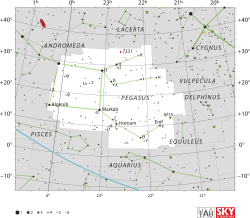Lambda Pegasi

| |
| Observation data Epoch J2000 Equinox J2000 | |
|---|---|
| Constellation | Pegasus |
| Right ascension | 22h 46m 31.87786s[1] |
| Declination | +23° 33′ 56.3561″[1] |
| Apparent magnitude (V) | 3.96[1] |
| Characteristics | |
| Spectral type | G8II-III[2][3] |
| U−B color index | +0.96[1] |
| B−V color index | +1.07[1] |
| Astrometry | |
| Radial velocity (Rv) | -3.9[1] km/s |
| Proper motion (μ) | RA: 55.75[1] mas/yr Dec.: -10.15[1] mas/yr |
| Parallax (π) | 8.93 ± 0.24[4] mas |
| Distance | 365 ± 10 ly (112 ± 3 pc) |
| Absolute magnitude (MV) | -1.45[3] |
| Details | |
| Mass | ~1,5[2] M☉ |
| Radius | 28.5[2][5] R☉ |
| Luminosity | 390[2] L☉ |
| Temperature | 4,933[6] K |
| Metallicity [Fe/H] | 0.12[6] dex |
| Rotational velocity (v sin i) | 8.0[7] km/s |
| Other designations | |
| Database references | |
| SIMBAD | data |
Coordinates: ![]() 22h 46m 31.9s, +23° 33′ 56.0″
22h 46m 31.9s, +23° 33′ 56.0″
Lambda Pegasi (λ Peg, λ Pegasi) is a fourth-magnitude star in the constellation Pegasus. It has the traditional name Sadalpheretz,[8] sometimes spelled Sadalpheris or Sad Al Faris, from the Arabic سعد الفرس meaning "Luck of the Stallion", its etymology similar to that of the star Alpheratz, with both referring to the mythological winged-horse Pegasus.
Sadalpheretz is a yellow giant with stellar classification G8II-III. With a mass of 1.5 M☉ and radius that is 28.5 R☉, the star boasts a bolometric luminosity that is roughly 390 L☉.[2] Its apparent magnitude was calibrated in 1983 at 3.96, yielding an intrinsic brightness of -1.45.[3] Parallax calculations place the star at a distance of roughly 112 parsecs from Earth, or 365 ± 10 light years away,[4] about three times the distance of its line-of-sight double Sadalbari.
In the constellation, Lambda and Mu lie to the southwest of Beta Pegasi, the nearest bright star.
See also
- Lists of stars in the constellation Pegasus
- Class G Stars
- Giant star
References
- 1 2 3 4 5 6 7 8 "SIMBAD query result: lam Peg -- Star". Centre de Données astronomiques de Strasbourg. Retrieved 2012-08-28.
- 1 2 3 4 5 Smith, G. (November 1998). "Stellar atmospheric parameters for the giant stars MU Pegasi and lambda Pegasi" (PDF). Astronomy & Astrophysics. 339: 531–536. Bibcode:1998A&A...339..531S. Retrieved 2012-08-28.
- 1 2 3 "λ Pegasi". Wolfram Alpha. Retrieved 2012-08-28.
- 1 2 van Leeuwen, F. (November 2007). "Validation of the new Hipparcos reduction". Astronomy and Astrophysics. 474 (2): 653–664. arXiv:0708.1752
 . Bibcode:2007A&A...474..653V. doi:10.1051/0004-6361:20078357.
. Bibcode:2007A&A...474..653V. doi:10.1051/0004-6361:20078357. - ↑ Kaler, James B. "SADALBARI (Lambda and Mu Pegasi)". Stars. University of Illinois. Retrieved 2012-08-28.
- 1 2 Koleva, M.; Vazdekis, A. (February 2012). "Stellar population models in the UV. I. Characterisation of the New Generation Stellar Library". Astronomy & Astrophysics. 538, id.A143: A143. arXiv:1111.5449
 . Bibcode:2012A&A...538A.143K. doi:10.1051/0004-6361/201118065.
. Bibcode:2012A&A...538A.143K. doi:10.1051/0004-6361/201118065. - ↑ Hekker, S.; Meléndez, J. (December 2007). "Precise radial velocities of giant stars. III. Spectroscopic stellar parameters". Astronomy and Astrophysics. 475 (3): 1003–1009. arXiv:0709.1145
 . Bibcode:2007A&A...475.1003H. doi:10.1051/0004-6361:20078233.
. Bibcode:2007A&A...475.1003H. doi:10.1051/0004-6361:20078233. - ↑ "YILDIZ ADLARI SÖZLÜĞÜ (Glossary of Star Names)". Mustafa Pultar. Retrieved 2012-08-28.
